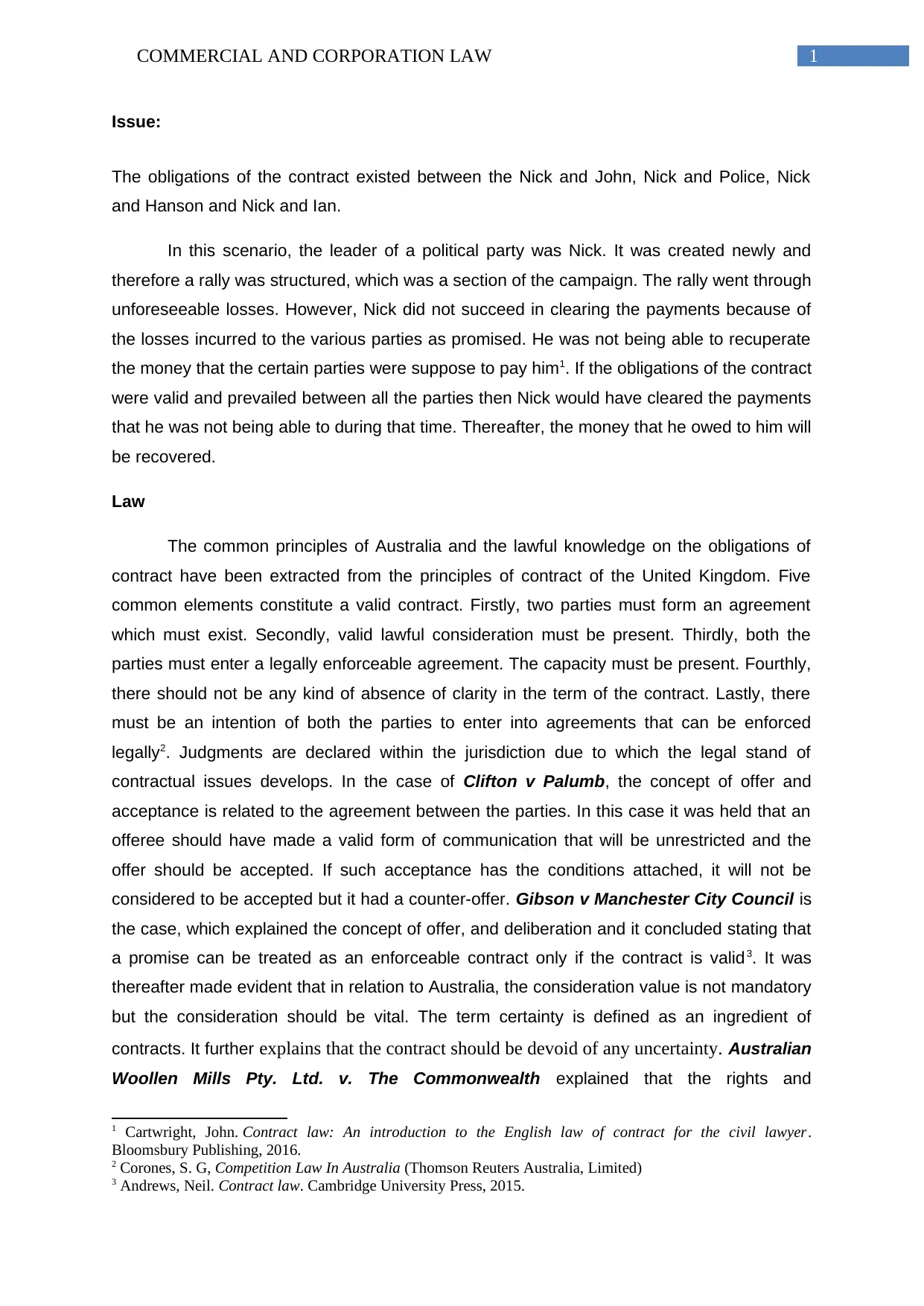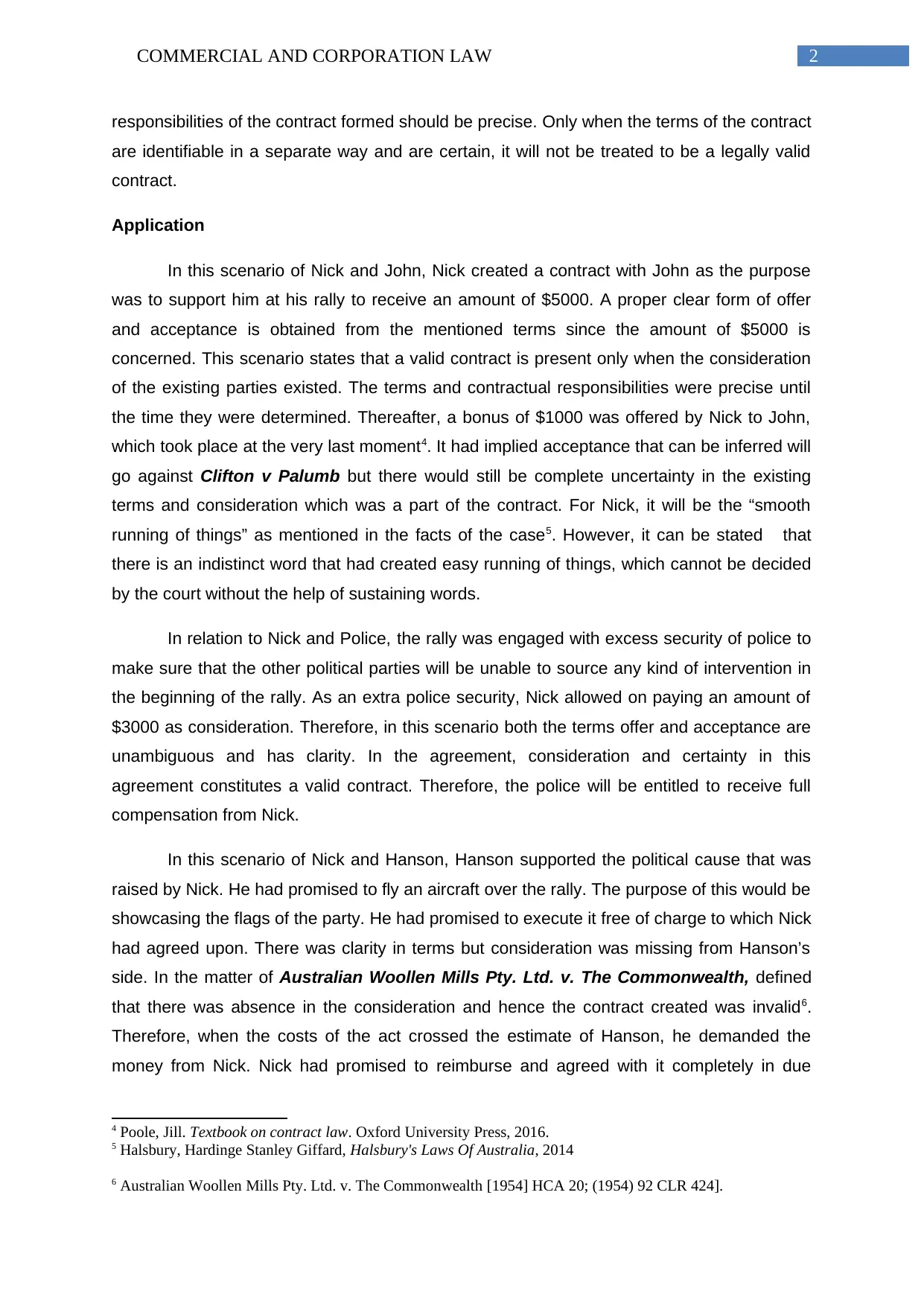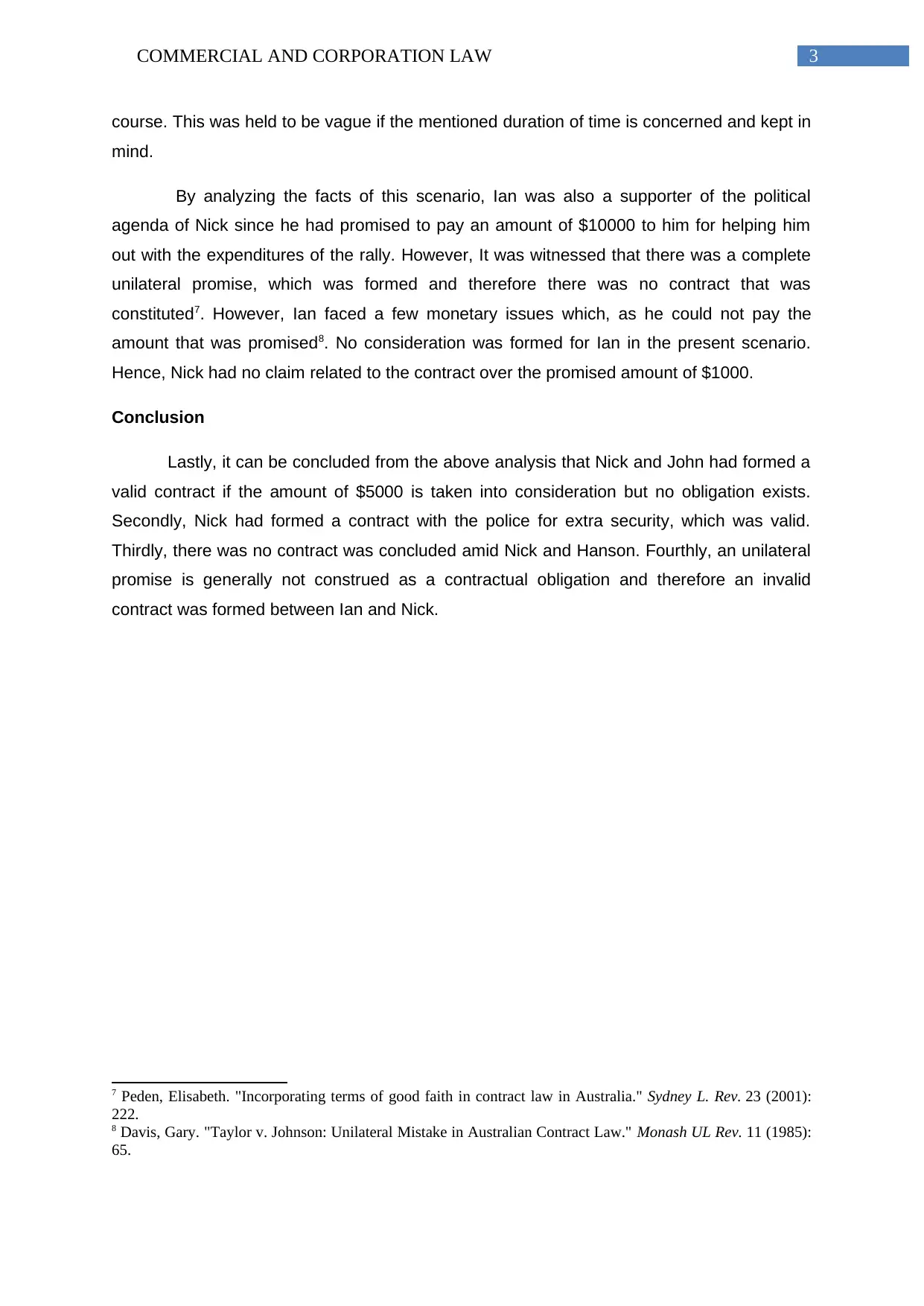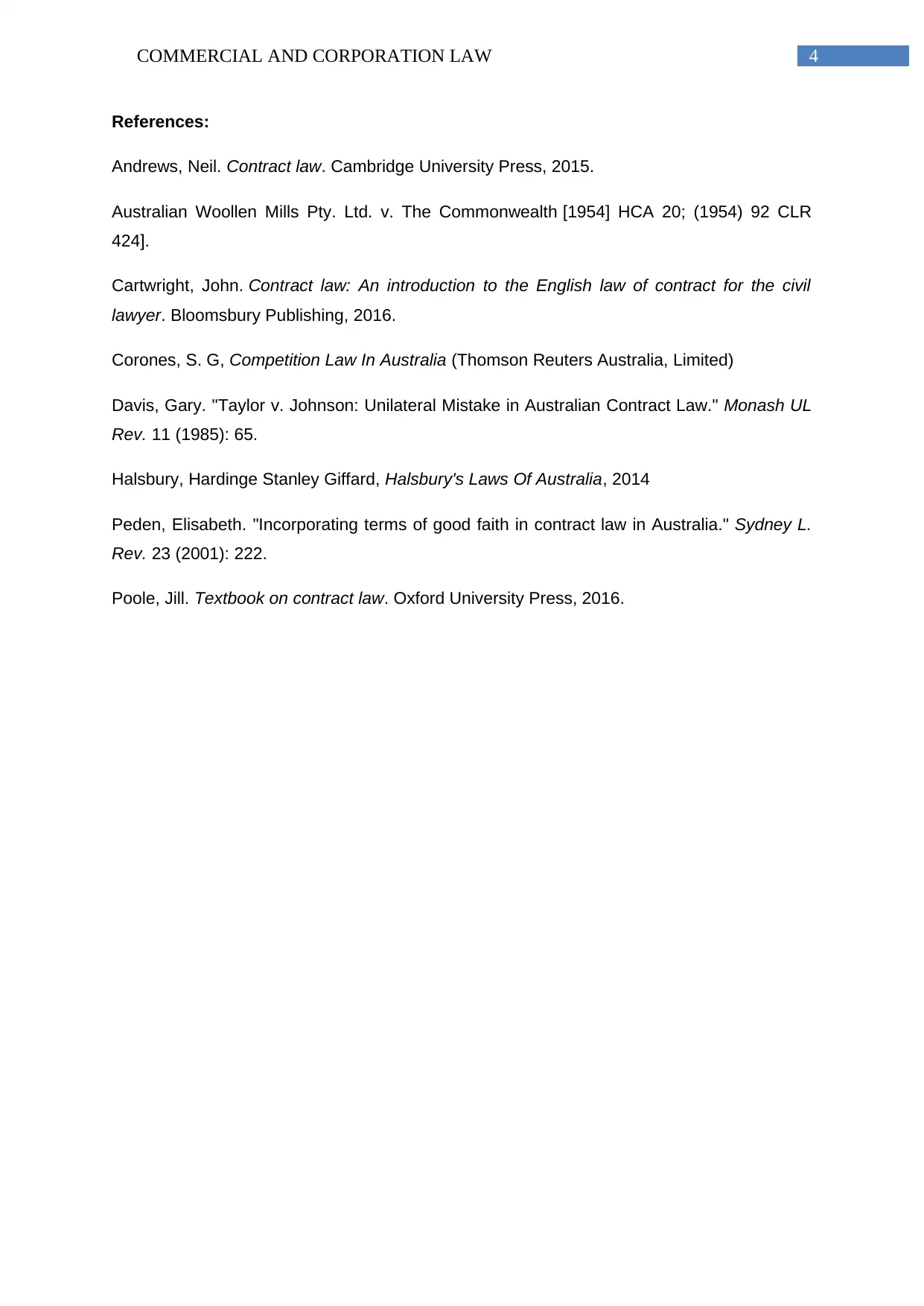Commercial and Corporation Law: Contractual Obligations Report
VerifiedAdded on 2021/04/21
|5
|1360
|37
Report
AI Summary
This report provides a detailed analysis of contractual obligations within the context of commercial and corporation law. It examines several scenarios involving a political party leader named Nick, who entered into agreements with various parties for a rally. The report explores the validity of these contracts based on Australian law, referencing key legal principles such as offer and acceptance, consideration, certainty, and the intention to create legal relations. The analysis considers the agreements between Nick and John, Nick and the Police, Nick and Hanson, and Nick and Ian, assessing whether valid contracts were formed and whether obligations were enforceable. The report applies relevant case law, including Clifton v Palumb, Gibson v Manchester City Council, and Australian Woollen Mills Pty. Ltd. v. The Commonwealth, to determine the rights and responsibilities of each party. The conclusion summarizes the validity of each contract and the resulting obligations.

Running head: COMMERCIAL AND CORPORATION LAW
Commercial and Corporation Law
Name of the Student
Name of the University
Author note
Commercial and Corporation Law
Name of the Student
Name of the University
Author note
Paraphrase This Document
Need a fresh take? Get an instant paraphrase of this document with our AI Paraphraser

1COMMERCIAL AND CORPORATION LAW
Issue:
The obligations of the contract existed between the Nick and John, Nick and Police, Nick
and Hanson and Nick and Ian.
In this scenario, the leader of a political party was Nick. It was created newly and
therefore a rally was structured, which was a section of the campaign. The rally went through
unforeseeable losses. However, Nick did not succeed in clearing the payments because of
the losses incurred to the various parties as promised. He was not being able to recuperate
the money that the certain parties were suppose to pay him1. If the obligations of the contract
were valid and prevailed between all the parties then Nick would have cleared the payments
that he was not being able to during that time. Thereafter, the money that he owed to him will
be recovered.
Law
The common principles of Australia and the lawful knowledge on the obligations of
contract have been extracted from the principles of contract of the United Kingdom. Five
common elements constitute a valid contract. Firstly, two parties must form an agreement
which must exist. Secondly, valid lawful consideration must be present. Thirdly, both the
parties must enter a legally enforceable agreement. The capacity must be present. Fourthly,
there should not be any kind of absence of clarity in the term of the contract. Lastly, there
must be an intention of both the parties to enter into agreements that can be enforced
legally2. Judgments are declared within the jurisdiction due to which the legal stand of
contractual issues develops. In the case of Clifton v Palumb, the concept of offer and
acceptance is related to the agreement between the parties. In this case it was held that an
offeree should have made a valid form of communication that will be unrestricted and the
offer should be accepted. If such acceptance has the conditions attached, it will not be
considered to be accepted but it had a counter-offer. Gibson v Manchester City Council is
the case, which explained the concept of offer, and deliberation and it concluded stating that
a promise can be treated as an enforceable contract only if the contract is valid3. It was
thereafter made evident that in relation to Australia, the consideration value is not mandatory
but the consideration should be vital. The term certainty is defined as an ingredient of
contracts. It further explains that the contract should be devoid of any uncertainty. Australian
Woollen Mills Pty. Ltd. v. The Commonwealth explained that the rights and
1 Cartwright, John. Contract law: An introduction to the English law of contract for the civil lawyer.
Bloomsbury Publishing, 2016.
2 Corones, S. G, Competition Law In Australia (Thomson Reuters Australia, Limited)
3 Andrews, Neil. Contract law. Cambridge University Press, 2015.
Issue:
The obligations of the contract existed between the Nick and John, Nick and Police, Nick
and Hanson and Nick and Ian.
In this scenario, the leader of a political party was Nick. It was created newly and
therefore a rally was structured, which was a section of the campaign. The rally went through
unforeseeable losses. However, Nick did not succeed in clearing the payments because of
the losses incurred to the various parties as promised. He was not being able to recuperate
the money that the certain parties were suppose to pay him1. If the obligations of the contract
were valid and prevailed between all the parties then Nick would have cleared the payments
that he was not being able to during that time. Thereafter, the money that he owed to him will
be recovered.
Law
The common principles of Australia and the lawful knowledge on the obligations of
contract have been extracted from the principles of contract of the United Kingdom. Five
common elements constitute a valid contract. Firstly, two parties must form an agreement
which must exist. Secondly, valid lawful consideration must be present. Thirdly, both the
parties must enter a legally enforceable agreement. The capacity must be present. Fourthly,
there should not be any kind of absence of clarity in the term of the contract. Lastly, there
must be an intention of both the parties to enter into agreements that can be enforced
legally2. Judgments are declared within the jurisdiction due to which the legal stand of
contractual issues develops. In the case of Clifton v Palumb, the concept of offer and
acceptance is related to the agreement between the parties. In this case it was held that an
offeree should have made a valid form of communication that will be unrestricted and the
offer should be accepted. If such acceptance has the conditions attached, it will not be
considered to be accepted but it had a counter-offer. Gibson v Manchester City Council is
the case, which explained the concept of offer, and deliberation and it concluded stating that
a promise can be treated as an enforceable contract only if the contract is valid3. It was
thereafter made evident that in relation to Australia, the consideration value is not mandatory
but the consideration should be vital. The term certainty is defined as an ingredient of
contracts. It further explains that the contract should be devoid of any uncertainty. Australian
Woollen Mills Pty. Ltd. v. The Commonwealth explained that the rights and
1 Cartwright, John. Contract law: An introduction to the English law of contract for the civil lawyer.
Bloomsbury Publishing, 2016.
2 Corones, S. G, Competition Law In Australia (Thomson Reuters Australia, Limited)
3 Andrews, Neil. Contract law. Cambridge University Press, 2015.

2COMMERCIAL AND CORPORATION LAW
responsibilities of the contract formed should be precise. Only when the terms of the contract
are identifiable in a separate way and are certain, it will not be treated to be a legally valid
contract.
Application
In this scenario of Nick and John, Nick created a contract with John as the purpose
was to support him at his rally to receive an amount of $5000. A proper clear form of offer
and acceptance is obtained from the mentioned terms since the amount of $5000 is
concerned. This scenario states that a valid contract is present only when the consideration
of the existing parties existed. The terms and contractual responsibilities were precise until
the time they were determined. Thereafter, a bonus of $1000 was offered by Nick to John,
which took place at the very last moment4. It had implied acceptance that can be inferred will
go against Clifton v Palumb but there would still be complete uncertainty in the existing
terms and consideration which was a part of the contract. For Nick, it will be the “smooth
running of things” as mentioned in the facts of the case5. However, it can be stated that
there is an indistinct word that had created easy running of things, which cannot be decided
by the court without the help of sustaining words.
In relation to Nick and Police, the rally was engaged with excess security of police to
make sure that the other political parties will be unable to source any kind of intervention in
the beginning of the rally. As an extra police security, Nick allowed on paying an amount of
$3000 as consideration. Therefore, in this scenario both the terms offer and acceptance are
unambiguous and has clarity. In the agreement, consideration and certainty in this
agreement constitutes a valid contract. Therefore, the police will be entitled to receive full
compensation from Nick.
In this scenario of Nick and Hanson, Hanson supported the political cause that was
raised by Nick. He had promised to fly an aircraft over the rally. The purpose of this would be
showcasing the flags of the party. He had promised to execute it free of charge to which Nick
had agreed upon. There was clarity in terms but consideration was missing from Hanson’s
side. In the matter of Australian Woollen Mills Pty. Ltd. v. The Commonwealth, defined
that there was absence in the consideration and hence the contract created was invalid6.
Therefore, when the costs of the act crossed the estimate of Hanson, he demanded the
money from Nick. Nick had promised to reimburse and agreed with it completely in due
4 Poole, Jill. Textbook on contract law. Oxford University Press, 2016.
5 Halsbury, Hardinge Stanley Giffard, Halsbury's Laws Of Australia, 2014
6 Australian Woollen Mills Pty. Ltd. v. The Commonwealth [1954] HCA 20; (1954) 92 CLR 424].
responsibilities of the contract formed should be precise. Only when the terms of the contract
are identifiable in a separate way and are certain, it will not be treated to be a legally valid
contract.
Application
In this scenario of Nick and John, Nick created a contract with John as the purpose
was to support him at his rally to receive an amount of $5000. A proper clear form of offer
and acceptance is obtained from the mentioned terms since the amount of $5000 is
concerned. This scenario states that a valid contract is present only when the consideration
of the existing parties existed. The terms and contractual responsibilities were precise until
the time they were determined. Thereafter, a bonus of $1000 was offered by Nick to John,
which took place at the very last moment4. It had implied acceptance that can be inferred will
go against Clifton v Palumb but there would still be complete uncertainty in the existing
terms and consideration which was a part of the contract. For Nick, it will be the “smooth
running of things” as mentioned in the facts of the case5. However, it can be stated that
there is an indistinct word that had created easy running of things, which cannot be decided
by the court without the help of sustaining words.
In relation to Nick and Police, the rally was engaged with excess security of police to
make sure that the other political parties will be unable to source any kind of intervention in
the beginning of the rally. As an extra police security, Nick allowed on paying an amount of
$3000 as consideration. Therefore, in this scenario both the terms offer and acceptance are
unambiguous and has clarity. In the agreement, consideration and certainty in this
agreement constitutes a valid contract. Therefore, the police will be entitled to receive full
compensation from Nick.
In this scenario of Nick and Hanson, Hanson supported the political cause that was
raised by Nick. He had promised to fly an aircraft over the rally. The purpose of this would be
showcasing the flags of the party. He had promised to execute it free of charge to which Nick
had agreed upon. There was clarity in terms but consideration was missing from Hanson’s
side. In the matter of Australian Woollen Mills Pty. Ltd. v. The Commonwealth, defined
that there was absence in the consideration and hence the contract created was invalid6.
Therefore, when the costs of the act crossed the estimate of Hanson, he demanded the
money from Nick. Nick had promised to reimburse and agreed with it completely in due
4 Poole, Jill. Textbook on contract law. Oxford University Press, 2016.
5 Halsbury, Hardinge Stanley Giffard, Halsbury's Laws Of Australia, 2014
6 Australian Woollen Mills Pty. Ltd. v. The Commonwealth [1954] HCA 20; (1954) 92 CLR 424].
⊘ This is a preview!⊘
Do you want full access?
Subscribe today to unlock all pages.

Trusted by 1+ million students worldwide

3COMMERCIAL AND CORPORATION LAW
course. This was held to be vague if the mentioned duration of time is concerned and kept in
mind.
By analyzing the facts of this scenario, Ian was also a supporter of the political
agenda of Nick since he had promised to pay an amount of $10000 to him for helping him
out with the expenditures of the rally. However, It was witnessed that there was a complete
unilateral promise, which was formed and therefore there was no contract that was
constituted7. However, Ian faced a few monetary issues which, as he could not pay the
amount that was promised8. No consideration was formed for Ian in the present scenario.
Hence, Nick had no claim related to the contract over the promised amount of $1000.
Conclusion
Lastly, it can be concluded from the above analysis that Nick and John had formed a
valid contract if the amount of $5000 is taken into consideration but no obligation exists.
Secondly, Nick had formed a contract with the police for extra security, which was valid.
Thirdly, there was no contract was concluded amid Nick and Hanson. Fourthly, an unilateral
promise is generally not construed as a contractual obligation and therefore an invalid
contract was formed between Ian and Nick.
7 Peden, Elisabeth. "Incorporating terms of good faith in contract law in Australia." Sydney L. Rev. 23 (2001):
222.
8 Davis, Gary. "Taylor v. Johnson: Unilateral Mistake in Australian Contract Law." Monash UL Rev. 11 (1985):
65.
course. This was held to be vague if the mentioned duration of time is concerned and kept in
mind.
By analyzing the facts of this scenario, Ian was also a supporter of the political
agenda of Nick since he had promised to pay an amount of $10000 to him for helping him
out with the expenditures of the rally. However, It was witnessed that there was a complete
unilateral promise, which was formed and therefore there was no contract that was
constituted7. However, Ian faced a few monetary issues which, as he could not pay the
amount that was promised8. No consideration was formed for Ian in the present scenario.
Hence, Nick had no claim related to the contract over the promised amount of $1000.
Conclusion
Lastly, it can be concluded from the above analysis that Nick and John had formed a
valid contract if the amount of $5000 is taken into consideration but no obligation exists.
Secondly, Nick had formed a contract with the police for extra security, which was valid.
Thirdly, there was no contract was concluded amid Nick and Hanson. Fourthly, an unilateral
promise is generally not construed as a contractual obligation and therefore an invalid
contract was formed between Ian and Nick.
7 Peden, Elisabeth. "Incorporating terms of good faith in contract law in Australia." Sydney L. Rev. 23 (2001):
222.
8 Davis, Gary. "Taylor v. Johnson: Unilateral Mistake in Australian Contract Law." Monash UL Rev. 11 (1985):
65.
Paraphrase This Document
Need a fresh take? Get an instant paraphrase of this document with our AI Paraphraser

4COMMERCIAL AND CORPORATION LAW
References:
Andrews, Neil. Contract law. Cambridge University Press, 2015.
Australian Woollen Mills Pty. Ltd. v. The Commonwealth [1954] HCA 20; (1954) 92 CLR
424].
Cartwright, John. Contract law: An introduction to the English law of contract for the civil
lawyer. Bloomsbury Publishing, 2016.
Corones, S. G, Competition Law In Australia (Thomson Reuters Australia, Limited)
Davis, Gary. "Taylor v. Johnson: Unilateral Mistake in Australian Contract Law." Monash UL
Rev. 11 (1985): 65.
Halsbury, Hardinge Stanley Giffard, Halsbury's Laws Of Australia, 2014
Peden, Elisabeth. "Incorporating terms of good faith in contract law in Australia." Sydney L.
Rev. 23 (2001): 222.
Poole, Jill. Textbook on contract law. Oxford University Press, 2016.
References:
Andrews, Neil. Contract law. Cambridge University Press, 2015.
Australian Woollen Mills Pty. Ltd. v. The Commonwealth [1954] HCA 20; (1954) 92 CLR
424].
Cartwright, John. Contract law: An introduction to the English law of contract for the civil
lawyer. Bloomsbury Publishing, 2016.
Corones, S. G, Competition Law In Australia (Thomson Reuters Australia, Limited)
Davis, Gary. "Taylor v. Johnson: Unilateral Mistake in Australian Contract Law." Monash UL
Rev. 11 (1985): 65.
Halsbury, Hardinge Stanley Giffard, Halsbury's Laws Of Australia, 2014
Peden, Elisabeth. "Incorporating terms of good faith in contract law in Australia." Sydney L.
Rev. 23 (2001): 222.
Poole, Jill. Textbook on contract law. Oxford University Press, 2016.
1 out of 5
Related Documents
Your All-in-One AI-Powered Toolkit for Academic Success.
+13062052269
info@desklib.com
Available 24*7 on WhatsApp / Email
![[object Object]](/_next/static/media/star-bottom.7253800d.svg)
Unlock your academic potential
Copyright © 2020–2025 A2Z Services. All Rights Reserved. Developed and managed by ZUCOL.





